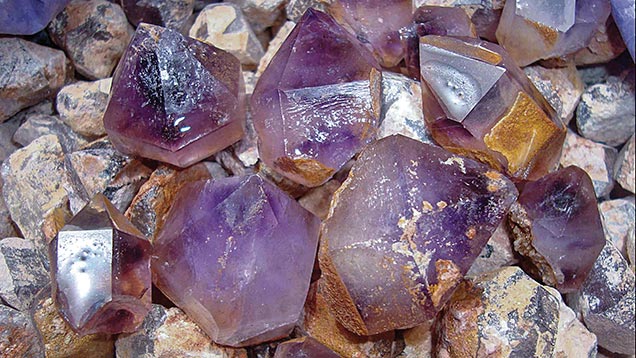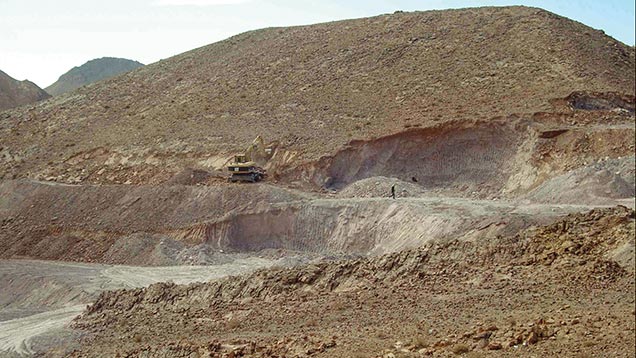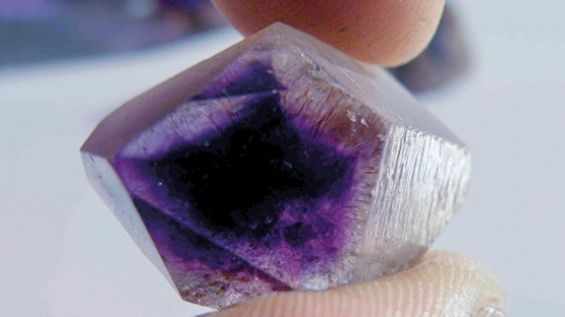In the middle of the Daraa-Tafilalet region in southern Morocco lays one of the most interesting mines in North Africa. In the Boudi locality, a violet variety of quartz called Amethysts has been discovered in 1990. The recent discovery reveals the unique characteristics of what is known nowadays as the Moroccan Amethyst. The fine stone, according to the official website of Gemporia, an American reserve auction jewelry shopping channel, Moroccan Amethyst is «one of the newest varieties of gemstone to be found».
The Amethyst crystals
Gemporia which sells the Boudi’s gems indicates that 27 years after the discovery, Amethysts were brought to the «world stage and set a new standard for quality Amethyst». Indeed, the gems found in Morocco are very unique. This was thoroughly explained by a study published on the Gemological Institute of America (GIA), an independent nonprofit that protects the gem and jewelry buying public through research, education and laboratory services, stating that Amethyst from Boudi have double terminations and hourglass-shaped color zoning.
«The crystals have well-developed prism faces (…) the color quality and distribution varies widely, from light purple to very deep purplish red, often showing sharp color concentration along the rhombohedral direction».
The shape and color of the Moroccan Amethysts make of them a real treasure, especially to the Quartz market. This Amethyst is more similar to Opal formation than Amethyst from other sources», indicates Gemporia. For the American media platform, most of Amethyst out there in the market is formed in geodes «which are essentially the limestone fossils of ancient tree trunks». Meanwhile, these Moroccan crystals are formed due to a process called «hydrothermal deposition», allowing them to perfectly be diamond-shaped.
 The amethysts extracted from the piles are still covered with matrix and carbonates. The well-shaped crystals range from 2 to 5 cm in diameter./Ph. by Abdelghani El Harfi and Salahaddine Mouaddib.
The amethysts extracted from the piles are still covered with matrix and carbonates. The well-shaped crystals range from 2 to 5 cm in diameter./Ph. by Abdelghani El Harfi and Salahaddine Mouaddib.
How they were sold
The Amethyst crystals from Boudi are also unique in a different sense. Discovered in 1990, the stones were extracted by local miners and sold to random tourists visiting the region. Villagers used classical methods and handheld tools to collect the crystals. No one knew about the Amethyst stones and their value in the world market. Years later, exactly in 2007, a foreign mineral dealer, namely Zee Haag, stumbled upon the Boudi’s treasure. Based on the account provided by the GIA, Zee Haag visited the locality in 2007.
«These specimens deputed internationally at the 2009 Mineral and Gem show at Sainte-Marie-aux-Mines, Europe’s second-largest mineral event», said the same source. Starting from there, the locality was known to the world and collectors and minors visited the site.
 he front of the open quarry in Boud./ Ph. Abdelghani El Harfi and Salahaddine Mouaddib.
he front of the open quarry in Boud./ Ph. Abdelghani El Harfi and Salahaddine Mouaddib.
The crystals now
In 2012, things changed for the Boudi’s locality and the Amethysts crystals. Geostone Group, a Moroccan company founded in 2011, was there to market the stones. After gaining exclusive rights to the mine, the company started producing Moroccan Amethysts crystals and selling them abroad.
Now the stones are used to decorate fine rings, necklaces and pieces of jewelry (sold for £29 to £571). Gemporia is one of the companies that sell the Moroccan Amethyst. On its website it stated that «the owners of the now world famous Moroccan Amethyst mine, responsible for bringing this unique and distinctive variety of Amethyst to the market, working exclusively with Gemporia».





 chargement...
chargement...












